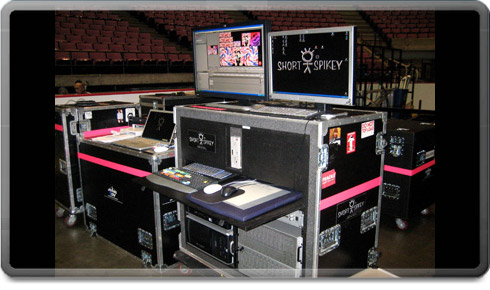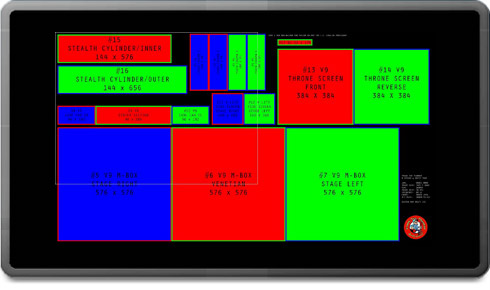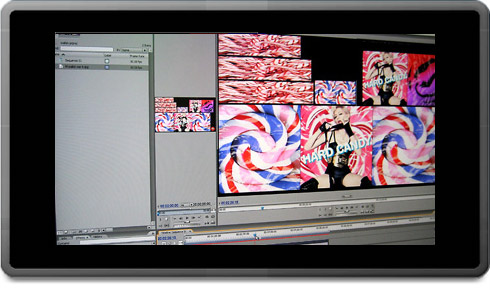Sticky, Sweet… and powered by Mac
M-Tribe reader Ian sent in the link to an interesting behind the scenes look at the video projections of Madonna’s Sticky & Sweet Tour.
The man behing the console was once again Jason Harvey, familiar to MadonnaTribe readers thanks to the exclusive chat we had with him at the time of the Confessions Tour. And once again the technology behind the screens was powered by Mac.
Case Study: Jason Harvey
Occupation: Video Engineer for Madonna’s Sticky & Sweet tour
Gear: Mac Pro, plus redundant backups. 17 high-definition video screens. Numerous MacBooks and MacBook Pros. Most-used apps include PRG Mbox EXtreme Media Server and Adobe’s Premiere, After Effects, and Photoshop.
Madonna’s been working her particular brand of stardom for the last 26 years. And she is nothing if not an icon. Whether you love her music or could easily live without it, there’s no denying that Madonna has been one of the most provocative pop musicians of her time. And while her dance-floor-friendly confections are no small part of the Madonna mystique, her willingness to push the envelope visually and artistically is what sets her apart from her contemporaries.
Her latest live tour, the aptly named Sticky & Sweet, features a cavalcade of dancers, musicians, and even a snow-white Auburn Boattail Speedster, in addition to 17 high-definition video displays—the largest of which is 20 feet by 20 feet. And throughout the nearly 2-hour show, each of those 17 screens is filled with custom video—prerecorded, as well as live clips—thanks to a bunch of Apple tech.

For video engineer Jason Harvey, the day of the show is a long one. In addition to the 6 to 8 hours of setup the previous day, Harvey arrives at the venue on show days around 9 a.m. and usually finishes up around 3 a.m. the next morning. Prior to the show, Harvey is setting up video playback systems and video cameras used during the performance. And the whole thing runs almost entirely on Macs. “My whole entire crew—apart from one guy—uses MacBook Pros. Every single element of the show, apart from two parts of it, is all run on Macs. The sound and lighting crews also use Mac Pros for the show.”

Harvey’s 10-person video crew (plus a camera operator borrowed from another department) is responsible for re-creating the stunning visuals to accompany Madonna’s 24-song set each night. The core of the system is a pair of Mac Pros—a main system and a backup—running PRG Mbox EXtreme Media Server. The crew’s workflow for this show has been entirely digital. “We’re 100 percent tapeless,” Harvey says. “All of the video has come to us as digitally, downloaded over the Internet, or on disc. It’s saved us loads of time over tape, and we have editing suites onsite if we need them.”

During the show, there are 17 separate video screens, many of which can be moved and reconfigured. The largest screens are a set of three massive 20-by-20-foot displays, which can be moved together to create a single seamless display 60 feet wide and 20 feet high. Additionally, there are moving displays onstage, which Madonna uses several times, including during her video duets with Pharrell Williams and Justin Timberlake—during “Beat Goes On” and “4 Minutes,” respectively. But perhaps the most engaging video element of the show is the “stealth screen,” a pair of concentric circular displays that descend from the ceiling of the venue and offer a variety of dramatic effects.
During “Devil Wouldn’t Recognize You,” a slow-burner from Madonna’s latest album Hard Candy, she emerges from within the stealth screen, singing from atop a grand piano as amazing high-speed footage of falling water surrounds her. “That footage was shot on a Phantom camera, which shoots 1,000 frames per second in HD. “We started with a flat piece of content, but we knew we wanted something that would be visually stunning when it was wrapped around,“ Harvey says.
Aside from the footage, the LED screen itself is a high-tech wonder, although its distinctive shape comes about in a rather low-tech manner. According to Harvey, the stealth screen is “not really meant to be circular. It’s a bunch of flat panels, and we had to do a bit of customization to make it go around, using cable ties and a couple small uprights.”
Between the elaborate graphics, video interludes, and live shots, Harvey says there are only a few minutes during the two-hour show when his crew isn’t pushing images. “There are 24 songs in the show, and maybe five minutes when there isn’t any video – basically when Madonna is talking to the audience.” And with all that uptime, Harvey’s crew has to be ready for anything. “We have redundant systems running the whole time. If anything goes down, you just jump from A to B and go from there. Our playback guy watches the playback, and if there’s a problem, he’s in charge of that.”
Click here to continue reading this article from MacLife.com. Thanks to Ian.
